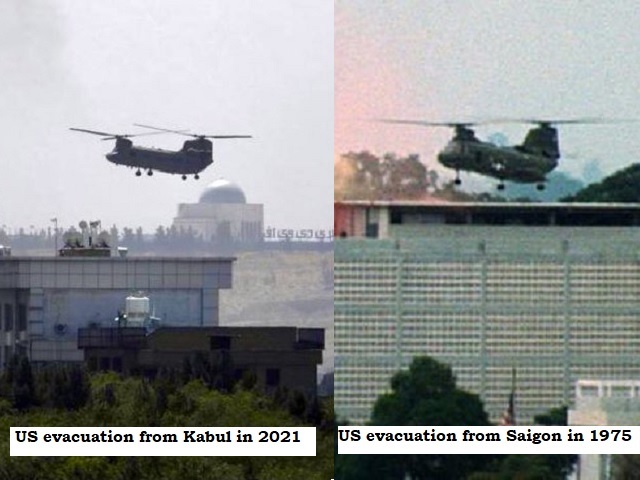
The fall of Kabul has drawn comparison to the fall of Saigon in 1975. Is it Saigon all over again? The Fall of Saigon refers to the capture of Saigon, the capital of South Vietnam, by the People’s Army of Vietnam in 1975.
Saigon’s capture had marked the end of the Vietnam War and the start of a transition period to the formal reunification of Vietnam into the Socialist Republic of Vietnam.
The US withdrawal from Kabul has been compared with the US withdrawal from Saigon. In fact, a photo comparison is making the rounds that shows US evacuation from Kabul in 2021 and US evacuation from Saigon in 1975.
Another “Saigon 75 – Kabul 21” comparison. pic.twitter.com/loNFaaRahp
— Julian Röpcke (@JulianRoepcke)
August 15, 2021
The US Secretary of State Antony Blinken has, however, insisted that the Afghan mission to be ‘successful’ and has rejected the comparison between Kabul and Saigon.
Kabul like Saigon pic.twitter.com/3617tlvfvU
— Matthieu🇫🇷🇪🇺 (@Simabras1)
August 15, 2021
What is Saigon?Thousands of Afghans fleeing Afghanistan, especially evacuation by the United States, have brought back ghosts from the past like Saigon, which also witnessed similar evacuations as North Vietnamese troops overran the city. Phnom Penh was also similar when the US ambassador had fled the city with some 200 other Americans just five days before the city fell to fanatical Khmer Rouge. Saigon is another name for Ho Chi Minh City, which is the largest city in Vietnam, situated in the south. |
Fall of Saigon
•The Fall of Saigon was the capture of Saigon, the capital of South Vietnam by the People’s Army of Vietnam (PAVN) on April 30, 1975.
•The capture of Saigon marked the end of the Vietnam War and the beginning of a transition period that led to the formal reunification of Vietnam into the Socialist Republic of Vietnam.
•The People’s Army of Vietnam under the command of General Văn Tiến Dũng had begun their final attack on Saigon on April 29, 1975.
•The Army of the Republic of Vietnam (ARVN) forces commanded by General Nguyễn Văn Toàn suffered a heavy artillery bombardment.
•The People’s Army of Vietnam finally occupied the important points of the city and raised their flag over the South Vietnamese presidential palace.
•The government of unified Vietnam renamed Saigon as Hồ Chí Minh City, to honor late North Vietnamese President Hồ Chí Minh.
•The capture of Saigon was preceded by Operation Frequent Wind, which comprised evacuation of almost all American civilian and military personnel in Saigon. Thousands of South Vietnamese civilians were also evacuated.
•The capture of Saigon followed a similar pattern to the capture of Kabul, as the Taliban increased its advances in Afghanistan after the withdrawal of US troops. Similarly in Saigon, the US ground combat units had left South Vietnam two years before the fall of Saigon and were not available to defend Saigon or assist in the evacuation.
•The evacuation from Saigon is known to be the largest helicopter evacuation in history.
Why is Saigon-Kabul comparison relevant now?
The biggest question now is that what will happen to Afghanistan under Taliban rule. Will the Taliban return to its old ways and act like the Vietnamese communists, who ordered mass executions. Will the women in Afghanistan be seen again as possessions of male members and be forbidden from gaining access to education, or will there be a more liberal approach, as promised by the Taliban.

